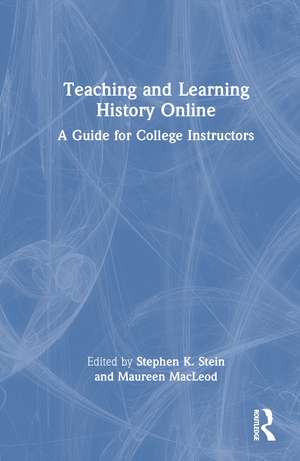Teaching and Learning History Online: A Guide for College Instructors
Editat de Stephen K. Stein, Maureen MacLeoden Limba Engleză Hardback – 17 apr 2023
| Toate formatele și edițiile | Preț | Express |
|---|---|---|
| Paperback (1) | 228.99 lei 3-5 săpt. | +10.80 lei 7-13 zile |
| Taylor & Francis – 17 apr 2023 | 228.99 lei 3-5 săpt. | +10.80 lei 7-13 zile |
| Hardback (1) | 891.07 lei 6-8 săpt. | |
| Taylor & Francis – 17 apr 2023 | 891.07 lei 6-8 săpt. |
Preț: 891.07 lei
Preț vechi: 1086.68 lei
-18% Nou
170.51€ • 182.33$ • 142.16£
Carte tipărită la comandă
Livrare economică 17 aprilie-01 mai
Specificații
ISBN-10: 1032192712
Pagini: 202
Ilustrații: 1 Tables, black and white
Dimensiuni: 152 x 229 x 13 mm
Greutate: 0.45 kg
Ediția:1
Editura: Taylor & Francis
Colecția Routledge
Locul publicării:Oxford, United Kingdom
Public țintă
ProfessionalNotă biografică
Stephen K. Stein is an Associate Professor of History and Department Chair for online programs at the University of Memphis, USA.
Maureen MacLeod is an Assistant Professor of History, Chair of the Humanities Department, and the History Program Director at Mercy College, USA.
Cuprins
Acknowledgements
About the Contributors
Introduction
Stephen K. Stein and Maureen MacLeod
Part 1: Administrative, Legal, and Technical Issues of Online Teaching
Maureen MacLeod
Chapter 1: Overcoming Resistance to Teaching History Online and Methods of Engagement
Rachel J. Mittelman
Chapter 2: Teaching to the Whole Class: Accessibility and Inclusivity in Teaching Online History Classes
Christina Ghanbarpour
Chapter 3: Balancing Act: Offering History Online from A Department Chair¿s Perspective
Kathleen A. Tobin
Chapter 4: Advising Online History Majors
Chrystal Goudsouzian and Amanda Lee Savage
Chapter 5: Working with Publisher Produced Material
David L. Toye
Chapter 6: Instructor, University and Other Contributors: Balancing Copyright Protections for Online Learning
Elizabeth F. Buchanan and Stephen K. Stein
Part 2: Innovative Pedagogy for the Online Class Stephen K. Stein and Maureen MacLeod
Chapter 7: More than a Mode of Delivery¿Benefits and Challenges of Teaching History Online
Elizabeth F. Buchanan
Chapter 8: Intercultural Learning Online: Using Students¿ Diverse Perspectives to Build Connections to History
Molly J. Giblin
Chapter 9: Using Technology in Pedagogy and Assessment: Timelines, Story Mapping, and Edpuzzles
Maureen MacLeod
Chapter 10: Dynamic Video Content in the Online History Classroom
Courtney Luckhardt
Chapter 11: Assessment and Feedback as Instruction in the Online History Classroom
Cassandra L. Clark
Chapter 12: Games and Gamification in Online History Classes
Mary A. Valante
Part 3: Online Discussion and Interactive Learning
Stephen K. Stein
Chapter 13: Creating Meaningful Online Discussions
Tony Acevedo
Chapter 14: Managing Online Discussions in Larger Sections
J. M. Wolfe
Chapter 15: Letting the Sources Guide the Way: The Dynamic Utilization of Primary Sources in the Online History Classroom
Micki Kaleta
Chapter 16: It¿s All Relative: The Importance of Scaffolding and Course Design in the Online History Classroom
Leigh Ann Wilson
Chapter 17: Interactive Timelines as the Center of Class Discussion
Brandon Morgan
Chapter 18: Using Omeka to Bring Women's History to Online Learners
Brigitte Billeaudeaux and Christine Eisel
Appendices
Bibliography
Descriere
Teaching and Learning History Online: A Guide for College Instructors offers everything a new online history instructor needs in one package, including how to structure courses, integrate multimedia, and manage and grade discussions, as well as advice for department chairs on curriculum management, student advising, and more.
In today’s technological society, online courses are quickly becoming the new normal in terms of collegiate instruction, providing the ideal environment to "flip the classroom" and encourage students to hone critical thinking skills by engaging deeply with historical sources. While much of the attention in online teaching focuses on STEM, business, and education courses, online history courses have also proven consistently popular. However, due to the COVID-19 pandemic, new history instructors are rushed into online teaching with little or no training or experience, creating a need for a guide to ease the transition from classroom to online course development and teaching.
A timely text, this book aims to provide both new and experienced college history teachers the information they need to develop dynamic online courses.
